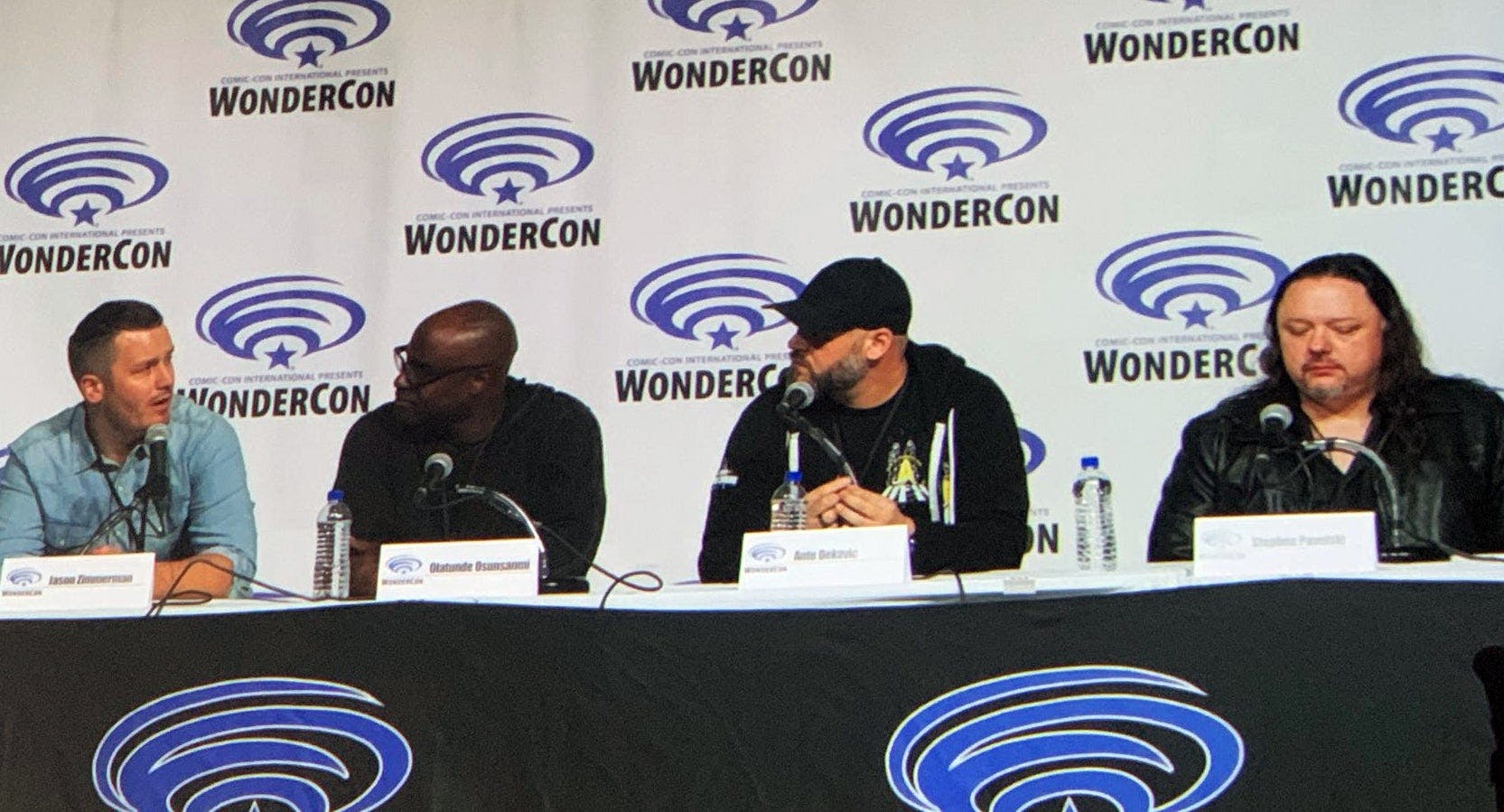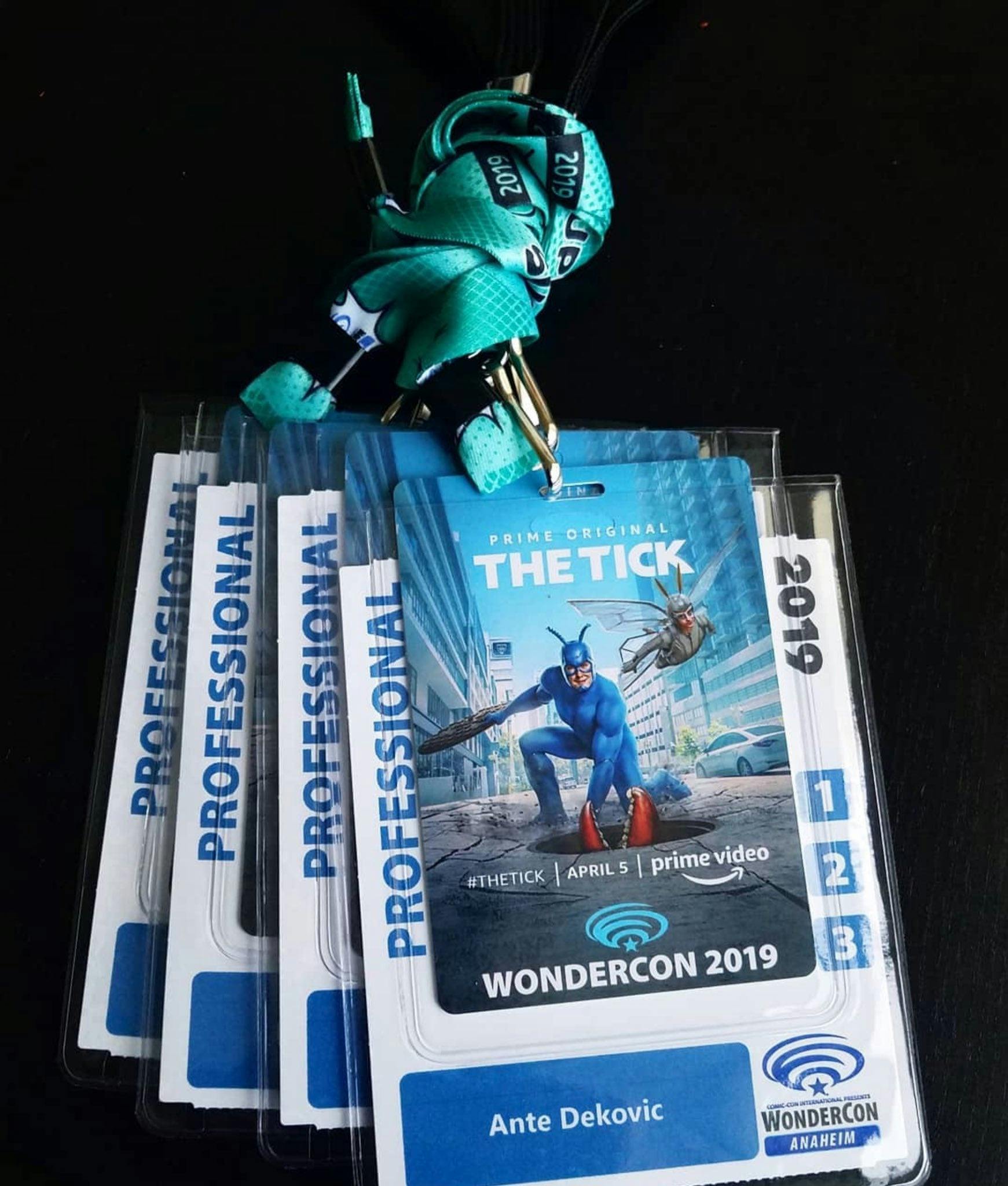Published Mar 31, 2019
'Discovery''s VFX Team Makes Magic Happen
On their WonderCon panel, our special effects wizards explain how they bring 'Star Trek' to life.

StarTrek.com
Between the fans, some great merch on the showroom floor (we spotted a great early ‘90s Klingon disruptor), and diverse panel programming, Star Trek was well represented at this year’s WonderCon in Anaheim, California. After checking out the floor (had to snag some of the great Trek issues available at the IDW booth, of course) and visiting Artists' Alley, we popped over to one of the two Trek panels on Saturday afternoon. The mid-afternoon offering, “Star Trek: Discovery: Inside the Special Effects,” featured the amazing Discovery VFX team, responsible for bringing you everything from baby Klingons to candle-lit quarters.
Panelists Olatunde Osunsanmi (Executive Producer and multi-episode director, Star Trek: Discovery), Jason Zimmerman (VFX Supervisor), Ante Dekovic (VFX supervisor), and Stephen Pavelski (Pre-Visualisation Supervisor) gathered to take us behind the scenes of the making of Discovery and their process for re-creating the world of Star Trek in the modern day. Fans got a glimpse behind the curtain as the team talked creature conceptualization, tech, and the logistics of shooting such an effects heavy show with nearly 500 artists scattered all across the globe.
StarTrek.com was there to capture it all; here’s what we learned.

StarTrek.com
How Does This Whole VFX Thing Work?
To answer that question, the panel started with an example: Being tasked to create the Section 31 ships.
“We started with concept art. [Then,] it’s usually a one [in the morning] phone call asking, how are we going to do it?” Osunsanmi explained. “First we ask what does the Section 31 ship do? Does it camouflage itself? What tech does it have that’s maybe slightly more advanced or more afield than the rest of Starfleet?”
“We shoot a lot of reference images to sample the writing of the set and then we drop him in. The idea is to blend him into the environment [with lighting] to make him look like he’s actually there” -Jason Zimmerman on the VFX of le-matya #StarTrekDiscoverypic.twitter.com/JQWZejqbJj
— Star Trek (@StarTrek) March 30, 2019
Once he’s helped the team conceptualize their design, the director’s role changes. Though they’re not working in front of the computer, building the VFX ships themselves, they still must work in tandem with the rest of the team. “Really the hardest thing about that when we’re shooting is to make sure that I frame the shot with enough room.” If there isn’t room in the shot for the amazing special effects that give Discovery it’s cinematic feel, then those shots simply can’t happen. “Often that’s what’s forgotten by the camera op or director — you have to imagine what’s not there and give them a shot wide enough to do their thing.”
Creating The World Of Discovery Isn’t Easy
“It’s always the scene you don’t see coming,” Zimmerman (who also goes by JZ) shared when asked which bit of VFX work had been the most difficult to achieve. The team talked about several difficult effects throughout the panel, but eventually Osunsanmi offered a final answer.
“I’d say the Red Angel,” the director answered. It wasn’t that the graphics were too difficult or groundbreaking to achieve, it was simply the number of people who had to be involved. “[Creating the Red Angel] took so much to get together, from costume department to the props department and VFX in there in the beginning. It took 18 weeks to build. VFX has to build a full [character] and then has to make sure it fits on the [actor] it’s supposed to go on. They have to make sure it does all these wondrous things it need to do, [but also] to make it feel real.”
“There are some episodes where there are so many visual effects that a director just doesn’t have time to get through and discuss stuff like camera angles. So we really do trust our vfx team to come through and create that spectacular shot” @CenterWillHold#StarTrekDiscovery
— Star Trek (@StarTrek) March 30, 2019
On the creation of the Red Angel, Dekovic added. “The challenging part is dealing with production and getting all the departments together and getting to that direction.”
The asteroid sequence that opens Discovery’s sophomore premiere was another challenge, and was a sequence that Zimmerman admitted they weren’t sure exactly how to do at first. Working within odd time constraints heightened the scene’s difficulty. “We were doing previews for the asteroid sequence while we were delivering episode 15 of season one…. It was all being done concurrently and we had to marry them together.”
How Do You Get An Actor To Act With Something That’s Not There?
The WonderCon audience was treated to a look at the rendering that went into creating the creature Michael encountered in the forest as a child. Longtime Trek creature and concept designer Neville Page was called in to decide what the monster should look like, but as real as the finished product seemed, it still couldn’t chase their young actress around the set for real.
“There’s nothing there,” Osunsanmi said. “Even for an adult actor [acting against VFX] is a bit of a challenge. [When we come up with a new VFX idea] it starts first with a call to JZ. Then Ante. Then, [in this case], we bounce it over to Neville to draw a bunch of different iterations [of the creature]. Then we do some boards with concept artists. The we get to the storyboard artist to actually see shot by shot what’s required for the production. By the time [the director] arrives on set they’re able to communicate clearly to the actor how high they should be looking — if [the shot] is 15 feet or 10 feet, things like that. Then they’re often given a stick with a little target on top of it.”
“In this case we had a guy in a green suit play the creature,” Dekovic added. “You always want to get the best performance out of an actor. If you have someone in the green suit it helps enormously, [rather than the actor] just looking at air.”
The Klingon World Became An Unexpected Challenge
When it comes to creating the look of Discovery, the VFX team isn’t trying to reinvent the wheel — a fact that they consider crucial.
“We definitely look back at what’s been done before,” Zimmerman said. “Trek has a very lasting legacy of visual effects and visuals in general, and you definitely want to start with that. Speaking for the art department as well, they do a lot of research and set us up with a lot of concept images to choose from. And then there is a little bit of how do we update that for [2019]?”
“We started with a bunch of concept art and talking with JZ ... every scene has a major VFX component to it and it’s usually a 1 am phone call asking ‘how are we going to do it?’” @CenterWillHold#StarTrekDiscoverypic.twitter.com/2kAEGSwOSh
— Star Trek (@StarTrek) March 30, 2019
The look of the Klingons has been one of Discovery’s notable updates, as those under L’Rell’s command look different from the warrior race that fans came to know in earlier series. The VFX team played large part in solving the challenge of building Discovery’s version of the Klingon home world. “Visualizing the Klingon world — the exterior — [was a challenge],” Osunsanmi shared. “The exteriors of what L’Rell's chambers would look like. There’s stuff out there, but what does that look like? What do we fly over? What do we see? That’s usually just an approximation. It’s never quite what the final thing is gonna be like. You need artists in the VFX realm to bring that home.”
What Can We Expect From Discovery’s Effects Going Forward?
Quality VFX don’t lead to good storytelling, but even the lowest level version of VFX tech can enhance what’s already great on the page. While the team didn’t have any groundbreaking tech news to share, they did leave the audience with this gem. “The one thing we can’t do with VFX is write the story or tell the story,” said Zimmerman. “We can make some really flashy stuff, but at the end of the day if we can’t tell a good Star Trek story then [the VFX] isn’t doing anyone any good.”
We couldn’t agree more.
Star Trek: Discovery Seasons 1-4 are currently streaming exclusively on Paramount+ in the U.S., the U.K., Switzerland, South Korea, Latin America, Germany, France, Italy, Australia, and Austria. Seasons 2 and 3 are also available on the Pluto TV Star Trek channel in Switzerland, Germany, and Austria. In Canada, it airs on Bell Media's CTV Sci-Fi Channel and streams on Crave. Star Trek: Discovery is distributed by Paramount Global Content Distribution.
Stay tuned to StarTrek.com for more details! And be sure to follow @StarTrek on Facebook, Twitter, and Instagram.
